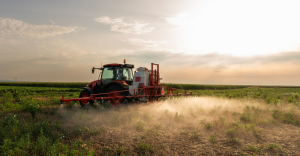Intensification of production in integrated crop-livestock systems (ILP) is a recurring need among livestock farmers. Several strategies can be adopted. One of them is the early pasture system.
Basically, this is a soybean-feed consortium system in which grass is sown between the soybean rows shortly after the soybeans emerge.
This measure makes it possible to anticipate the formation of pasture without reducing the productivity of the oilseed.
According to Embrapa researchers, the project’s creators, the system was recently validated with excellent results. Its DNA is to “anticipate” processes, increasing the results of the activity.
What is the early pasture system?
The Early Pasture System is an innovative crop-livestock integration (CLI) technique designed to optimize land use and increase productivity.
In this system, part of the fodder planting period takes place in intercropping between soybean lines.
This anticipates the establishment of pasture without reducing the grain productivity of the oilseed.
In an interview with Globo Rural magazine, Luiz Zago Machado, a researcher at Embrapa Agropecuária Oeste, pointed out that there have been many setbacks.
“We had the death of the grass by drift, the sale of the test plot, and even the death of the research partner grower.”
But, according to the researcher, the great challenge was to prevent grass from competing with soybeans. After all, it is the crop that pays the bill! And that’s what we’re going to talk about next.
How does the early pasture system work in the ILP?
The early pasture system is a technology solution that aims to anticipate pasture formation within 30 days.
With this strategy, the herd has pasture available for a longer period of time during the year (dry/winter season), when the producer has more difficulty in providing adequate food/nutrition for the animals.
In this system, the grass is planted between the soybean rows 14 to 20 days after the grain germination (stages V3 and V4).
This makes it possible to anticipate the formation of pasture for animals in the crop-livestock integration system (ILP), guaranteeing two to five arrobas more productivity per hectare.
According to Zago, the adoption of the system took a long time to be recommended because the validation had to go through 25 units.
He noted that the great challenge was to prevent grass from competing with soybeans.
“We did research with several soybean and grass varieties to find at the ideal consortium that maintains soybean productivity and ensure the anticipation of pasture formation from 30 to 60 days,” he said.
Once that is done, the recommendations for soybean and forage crops should be:
Soybean
- Size about 90 cm to 110 cm;
- Vigorous vegetative growth with good tillering;
- Select bedding varieties.
Forage, on the other hand, must have a low capacity to compete with soybeans. It must have the following characteristics:
- Small size;
- Slow initial growth;
- Should not produce stalks in the vegetative phase or thin stalks; and
- Tolerance to shade;
- Good forage production during the off-season.
Advantages of the early pasture system
Validated by Embrapa for the states of Mato Grosso, Goiás, Tocantins, Roraima, São Paulo, Minas Gerais, Paraná and Bahia, the early pasture system can offer advantages for both ranchers and farmers.
For ranchers, the solution helps to alleviate the lack of pasture in the dry season, the delay in the establishment of pastures and the failure of their formation.
For farmers, it is a real possibility to open new areas with integrated production systems (ILP), as well as the acquisition of land at affordable values and agricultural potential, in addition to improving soil conditions.
Thus, in general, the main advantages are:
- Does not compromise soybean grain yield;
- Allows cattle to enter the area in advance (between 30-60 days);
- Extension of the grazing period;
- Increase in meat production (+3 to 5 arrobas per hectare);
- Reduction of weeds: both in the soybean and in the pasture;
- Lower risk in the formation of pasture: time that precedes the conventional one;
- Does not compete for land with maize: the last plots in the sowing cycle;
- Grass is sown at a less turbulent time.
Exciting results
The implementation of the early pasture system is already being adopted by farmers in several municipalities in the south of Mato Grosso do Sul (Maracaju, Dourados, Nova Andradina, Anaurilândia, Rio Brilhante and Nova Alvorada do Sul).
With 270 hectares of early pasture system planted on the Rosa Branca farm in Rio Brilhante, producer Carlos Eduardo Barbosa, in an interview for Embrapa’s website, talked about his experience with the system.
He said he was very pleased with the results. “In addition to increasing pasture availability and improving cattle nutrition, grain productivity was excellent.”
The grower also details that in grass seeding, the soybean lines were spaced between 50 and 60 cm, and in areas where weeds were under control.
Even with this spacing, the grower notes that there was a high amount of straw and good distribution. He says there were no operational problems, such as interference with the separation of impurities from the soybeans.
With this, he emphasizes that the Early Pasture System works very well, adding that the technology can be useful “both in ILP systems and in properties with agriculture, where the producer intends to cycle nutrients, ensure a straw or even reduce the operational pressure at the time of transition”.
Carlos Eduardo also said that the experiences, which contributed to the validation of the early pasture system over these years, were positive and added that they have always made the early pasture system consortium using BRS Tamani.
The work, according to Barbosa, has brought great results. It has guaranteed an increase from 100 to about 150 days of grazing for cattle, providing two to three more arrobas per hectare.





